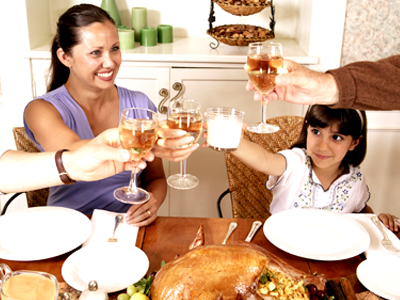
Thanksgiving marks the historic celebration between native Indians of America and pilgrims from Europe. The truth may not be as friendly as the history books portray, but it is easy to accept that native Indians and the pilgrims traded with each other and taught each other many things. Indians taught the pilgrims how to work the land, hunt and cure meat and fish.
Following one very difficult and challenging winter the pilgrims invited the Indians to celebrate their survival and thank them for sharing their knowledge and helping them. Both cultures celebrated for three days their abundance in an event that many regard as the nation's first Thanksgiving. The legacy of thanks and the feast have survived the centuries as the event became a national holiday in 1863 when President Abraham Lincoln proclaimed the last Thursday of November as a national day of thanksgiving. Later, President Franklin Roosevelt clarified that Thanksgiving should always be celebrated on the fourth Thursday of the month to encourage earlier holiday shopping.
Separate from any official holiday, every culture takes the opportunity to celebrate their accomplishments, victories and prosperity. Here in United States this day is reserved to make a stop in our busy lives and think about and appreciate all the things that we have. Hispanics in the United States have embraced the Thanksgiving celebration and added to its menu. Besides the traditional turkey, we now see tamales, pozole, birria, lomo, niño envuelto, and other dishes. Many times the music will start after dinner and Hispanics will be dancing and enjoying a festive time with family and friends.
I am grateful for so many things and recognize how important Thanksgiving is as a reminder and occasion to be grateful. I am grateful for all the opportunities that this country has allowed me to pursue. What are you grateful for?
¿Sabías que en Estados Unidos…?
- En 2011 hubo una producción de 248 millones de guajolotes (pavos). En 2010 la producción de pavos fue valorada en $4.37 billones de dólares.
- Solo seis estados en Estados Unidos (Minnesota, Carolina del Norte, Arkansas, Missouri, Virginia e Indiana) producen las dos terceras partes de los pavos que se consumieron en el país en 2011.
- En 2011 se produjeron 341 millones de kilos de arándanos (cranberries).
- Se espera una producción de 93 billones de kilos de camote (sweet potatoes). Principalmente la producción se lleva a cabo en Carolina del Norte.
- En 2010 se produjeron 500 millones calabazas. Con Illinois liderando en la producción.
- En 2009 la cantidad de pavo consumida en promedio por estadounidense fue de 6 kilos, sin lugar a dudas mucho de este consumo se realizó en el Día de Acción de Gracias. El consumo de camote fue de 2.4 kilos en promedio por persona.

